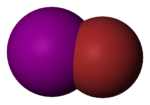Iodine monobromide

| |

| |

| |
| Names | |
|---|---|
| IUPAC name
Iodine monobromide
| |
| Other names
Iodine bromide
| |
| Identifiers | |
3D model (JSmol)
|
|
| ChemSpider | |
| ECHA InfoCard | 100.029.236 |
PubChem CID
|
|
| UNII | |
CompTox Dashboard (EPA)
|
|
| |
| |
| Properties | |
| IBr | |
| Molar mass | 206.904 g/mol |
| Appearance | dark red solid |
| Melting point | 42 °C (108 °F; 315 K) |
| Boiling point | 116 °C (241 °F; 389 K) |
| Related compounds | |
Other anions
|
iodine monochloride, iodine monofluoride |
Related interhalogen compounds
|
Iodine monochloride Iodine monofluoride Bromine monochloride |
Except where otherwise noted, data are given for materials in their standard state (at 25 °C [77 °F], 100 kPa).
| |
Iodine monobromide is an interhalogen compound with the formula IBr. It is a dark red solid that melts near room temperature.[1] Like iodine monochloride, IBr is used in some types of iodometry. It serves as a source of I+. Its Lewis acid properties are compared with those of ICl and I2 in the ECW model. It can form CT adducts with Lewis donors.[2]
Iodine monobromide is formed when iodine and bromine are combined in a chemical reaction:.[3]
- I2 + Br2 → 2 IBr
References
- ^ Greenwood, Norman N.; Earnshaw, Alan (1997). Chemistry of the Elements (2nd ed.). Butterworth-Heinemann. ISBN 978-0-08-037941-8.
- ^ Aragoni, M. Carla; Arca, Massimiliano; Demartin, Francesco; Devillanova, Francesco A.; Garau, Alessandra; Isaia, Francesco; Lippolis, Vito; Verani, Gaetano (2005-06-16). "DFT calculations, structural and spectroscopic studies on the products formed between IBr and N,N′-dimethylbenzoimidazole-2(3H)-thione and -2(3H)-selone". Dalton Transactions (13): 2252–2258. doi:10.1039/B503883A. ISSN 1477-9234. PMID 15962045.
- ^ M. Schmeisser (1963). "Iodine bromide IBr". In G. Brauer (ed.). Handbook of Preparative Inorganic Chemistry, 2nd Ed. Vol. 1. NY, NY: Academic Press. p. 291.
